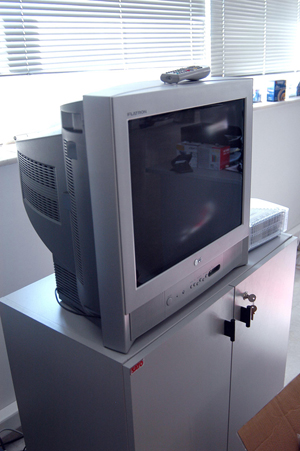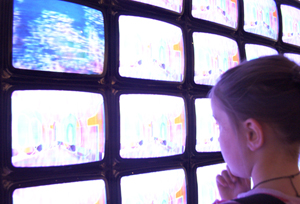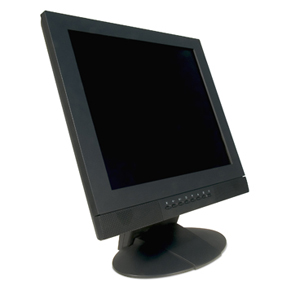From Analogical to Digital
by Rodolfo Cattani
New technology, old problems.
It is anticipated that between
2008 and 2012, the European Union will experience the change from analogical
television to digital television. This represents an important technological
event as well as a
considerable change in this popular means of communication which can even be
enjoyed by blind and visually impaired persons even if it means in a more
limited fashion.
a
considerable change in this popular means of communication which can even be
enjoyed by blind and visually impaired persons even if it means in a more
limited fashion.
In various countries the tendency for digital television is
taking place and in three experimental areas, the analogical signal is already
off: in Berlin and in the towns of Ferryside and Llansteffan in Wales .
.
The passage to digital television requires the purchase of a new
television or the adaptation of the existing one through a special receiver of
digital channels. People who are blind or visually impaired will experience some
difficulties managing the new televisions because there will be so many more
channels and navigation will have to be done on the screen with commands to move
upward, downward, to the right and to the left. Operators will have more space
to provide optional services and for that in every country measures will have to
be adopted in order to guarantee users their right to access these services. In
particular: an economic incentive, free help line, home installation by
qualified technicians; tools for the selection of frequences and integrated
digital televisions for receiving special channels for audiodescription;
measures for the use of electronic guides of programs, teletext and interactive
services.
As a matter of fact, visual impairment excludes spectators from a
wide variety of television programs whether they are for information or
entertainment. From the news, only verbal messages are received, the richest and
weightiest visual content is not at all transmitted or only partially so, apart
from the intervention of a few fortuitous prompters. Television is an instrument
of communication conceived for those who can see. And, since we live in an
environment which does not consider (or so little) the difficulties experienced
by people who have sensory disabilities, the needs of this population are not
taken into account eventhough fees are paid, acquiring therefore the right to
fully enjoy the service. But they remain in fact largely excluded from it.
Closed captioning on the televideo and interpretation in sign language are
special solutions which have facilitated greatly those with a hearing
impairment.
Images into
words
As it was previously mentioned, a form of compensation of such
exclusion exists even for blind people and it is called
audiodescription.
Audiodescription is the insertion in television programs of
a parallel narration which explains to spectators the images that they cannot
see, taking advantage of the intervals free of comments or dialogs present in
programs. In numerous countries, audiodescription is created in experimental or
occasional form, in some others, like Germany or England, it is regularly
practiced even in a limited fashion. Analogical television does not allow the
broadcasting of the track for audiodescription on the same broadcasting channel
of the audio program if not by incorporating it fully in it (an undesired effect
for many) or using one of the stereo channels reducing however the sound
quality. For this reason, for exemple, in Italy it was preferred to transmit the
sound track of the audiodescription on
a different radio frequency which can be listened to separately without
synchronicity with the flow of images. It is truly a questionable solution
because it marginalizes spectators who are visually impaired and prevents the
use of the service from a wider public composed of sighted persons who could
appreciate it.
on
a different radio frequency which can be listened to separately without
synchronicity with the flow of images. It is truly a questionable solution
because it marginalizes spectators who are visually impaired and prevents the
use of the service from a wider public composed of sighted persons who could
appreciate it.
The flourishing market of compact disks and DVDs
audiodescribed in the USA, and rapidly growing as well in Germany and in France,
demonstrates that the idea is not at all uncommon and that numerous people enjoy
audiodescription.
New perspectives
With the arrival
of digital television, providing an audiodescribed program will be much easier
from a technical point of view because of the wide availability of additional
channels. Audiodescription can be transmitted in synchronicity, leaving to the
individual the possibility of regulating the intensity of the sound for each
track, allowing a personalized listening experience or together with others. The
digital television also allows a better use of closed captioning.
However, if
for closed captioning the difficulties are only managerial, for audiodescription
the technical feasibility of the service is compromised by the lack of European
standards for receiving units, as it is illusory to believe that the new digital
televisions will be equipped in an adequate manner for such a goal. While in
England there already exists a legislation which requires public television to
provide a growing percentage of audiodescribed programs in order to reach 100%
in 2010, little is said in the other countries of the Union.
Not only that,
there is also another important and pressing issue which is the accessibility
for blind and visually impaired persons to guides to television programs and interactive digital
television through which, in the near future, will be managed numerous services,
such as relations with public administration, telemedical services, electronic
commerce, election procedures and more.
television programs and interactive digital
television through which, in the near future, will be managed numerous services,
such as relations with public administration, telemedical services, electronic
commerce, election procedures and more.
Our
initiatives
The European Blind Union has moved at the right time to
face these problems and already in 1996 the General Assembly, held in Italy in
Giardini Naxos, approved a resolution which recommended the adoption of
initiatives in this sense at the European level.
In spite of the important
commitment in recent years particulary that of the English, results have not
been satisfying since public directives regarding telecommunications and related
equipment have not received the requirements of users with disabilities.
The
main European legislative instrument on radiotelevision broadcasting is the
Television Without Borders Directive which establishes minimal standards in
various areas. This Directive concerns the common market and aims at the freedom
of movement of television services beyond borders.
The Directive was
published the first time in 1989 and was updated only once in 1997. Now, the
Directive is about to be amended again and the European Commission intends to
present a proposal in the coming year.
The main issues being discussed are in
general to what extent audiovisual services have to be regulated within the
Union, should the Directive be extended to include web broadcasting (web
casting), radio broadcasting, and new media; how much flexibility should there
be for regulations concerning publicity; the media commitment to promote and
protect the European cultural heritage; the issue about minors; the principle of
the country of origin on the basis of which is set what state member has
jurisdiction.
The European Blind Union follows with interest the course of
the Directive and intends, among other things, to obtain that the European
Commission anticipate in Article 4 of the new Directive the predisposition of a
relationship on monitoring accessibility by persons with disabilities in Europe.
Such monitoring should be based on statistics compiled in member countries
concerning the level of services on their channels, and action plans by
individual states to increase such levels. The EBU considers very important the
results of the survey by the Commission on accessibility of services and is
preparing a questionnaire which will be sent to member organizations to learn
the level of such services in respective countries.
In conclusion, it seems
clear that the arrival of the digital television is of fundamental importance
for blind and visually impaired persons, but if accessibility issues are
not addressed they will remain even more isolated and excluded of the use of
services available to other citizens. Television, whether good or bad, is an
essential instrument and will be so more and more in our information society;
blind and visually impaired persons do not want to be deprived of the
opportunity that it can offer them.